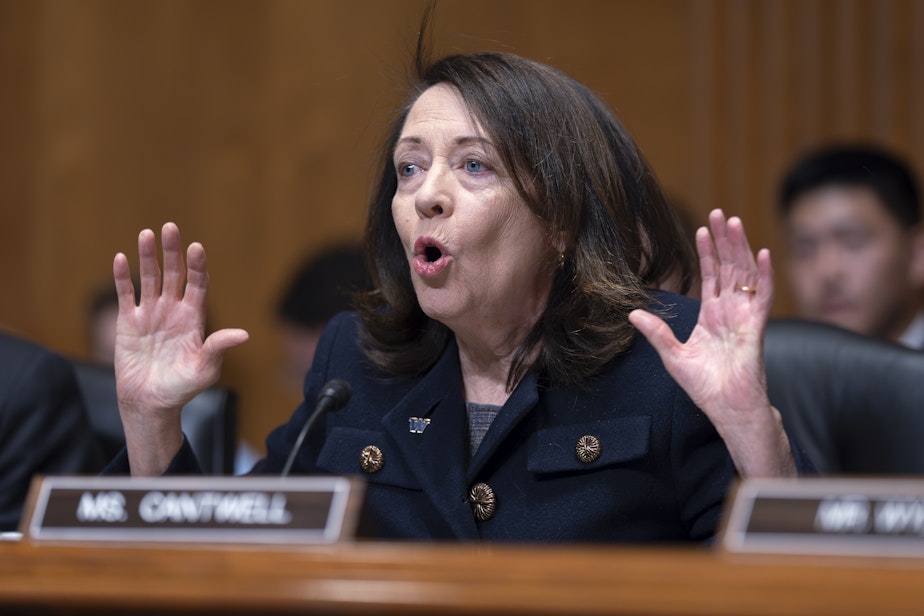Sen. Cantwell says weather service cuts could rain trouble on Washington state

The federal government plays a major role in predicting weather and fighting wildfires.
Experts say the Trump administration's job cuts to the National Weather Service could hurt those efforts.
Washington Sen. Maria Cantwell pulled a fire alarm of sorts on Tuesday: She said President Trump's cuts to the National Weather Service will put rural communities in Washington at risk during the upcoming fire season.
In a press conference, Cantwell held up a map. It showed the risk for fires in Washington state this summer. Nearly the whole state was covered in red, indicating above-normal fire risk.
“If you have very high wind events, the challenges that we are facing in a fire season...there's almost an inability to deal with them," Cantwell said. "So, we want to know when those conditions are going to exist because lives are at stake. Lives are at stake at fighting the fire, and if you're going to have these kind of unbelievable wind events, we need to be better prepared.”

The National Weather Service, part of the National Oceanographic and Atmospheric Administration, has cut around 600 employees this year, through a mix of firings and voluntary or incentivized departures. That's according to an open letter signed by all former heads of the agency. The letter's authors described additional activities that can't happen without accurate weather predictions, including:
Sponsored
- Airplanes can’t fly safely.
- Ships and boats of all kinds can't avoid storms, [whether on the high seas or on Puget Sound].
- Farmers can't make informed decision about planting crops.
- Dam and reservoir operators can't manage the water supply.
RELATED: Stabilizing 'operations,' the National Weather Service hires again after Trump cuts
NOAA is an agency within the U.S. Department of Commerce. During a Senate Appropriations Committee meeting this week, Commerce Secretary Howard Lutnick pushed back on the idea that he had gutted the National Weather Service.
"We have 2,100 meteorologists," he told the committee. "We are fully staffed with scientists and forecasters. Under no circumstances am I going to let public safety or public forecasting be cut."
But that rebuttal doesn't ring true for some officials and former officials whose tenures ended earlier this year. With hurricane season underway, some local offices for the National Weather Service don't even have a leader, said Brian LaMarre at Cantwell's press conference. La Marre is a retired NWS meteorologist-in-charge who headed the NWS Weather Forecast Office serving Tampa, Florida.
Sponsored
Staff shortages have led to a public backlash in hurricane-prone states.
RELATED: Where does your weather forecast come from?
This week, a union official told NPR the agency plans to refill around 20% of the empty positions (126 out of 550 positions).
Experts say the federal weather agency can't restore accuracy to weather data with only a skeleton crew, and that refilling positions does not happen instantaneously.
"These new hires MIGHT be ready in time for winter," a National Weather Service employee who requested anonymity to avoid retribution said in a text message. "But for severe weather season and hurricane season in the east and fire season in the west, the current low staffing is what we have to work with."
Sponsored
At Cantwell's press conference, retired television meteorologist Jeff Renner said the National Weather Service has lost talented specialists who track wildfire behavior.
“ Not only do they have the business of alerting local communities to the potential for danger, but also providing guidance for the response crews, the very courageous men and women who respond to these, who seek to both suppress and also eliminate or extinguish those fires,” he said.
He said large amounts of timber lands could also be at risk.
RELATED: Wildfire experts in Washington state warn of fallout from Trump’s Forest Service cuts
The Trump administration has said it intends to improve wildland firefighting "by consolidating and unifying federal wildland fire responsibilities into a new Federal Wildland Fire Service at the Department of the Interior. "
Sponsored
This story includes additional reporting by John Ryan.




